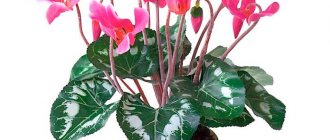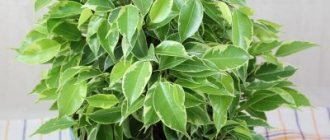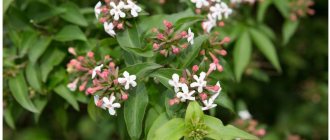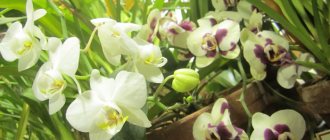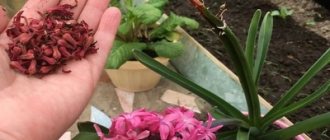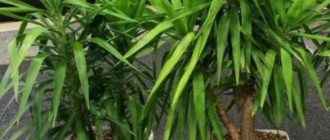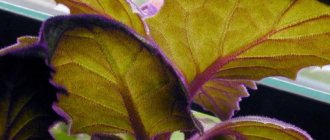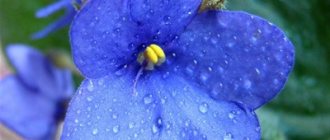Propagation of clivia by side shoots
This method of propagating a blooming beauty is the most reliable and simplest. In a pot with an adult plant, over time you can find small sprouts on the sides. These are the “babies” that should be removed from the mother part of the flower when they already have four strong leaves.
The process of planting side shoots must be carried out by adhering to simple but mandatory rules:
- each shoot should have 3-4 leaves;
- the plant can be disturbed only after the end of its flowering period for the current year;
- the “babies” should be separated carefully, taking care to preserve the integrity of the roots of the mother flower system and young shoots;
- accidentally injured roots should be covered with a layer of wood ash in the areas of damage.
The shoots are planted in personal pots 7 cm in diameter. For an adult flower, a small pot is also used. The root system of clivia loves close quarters . With this condition of the roots, the leaves of the flower grow fleshier and richer green.
The first two days after planting, the plant is not watered and kept warm at 20-25 degrees. Then moderate watering is gradually resumed. Young plants will bloom for the first time in 2-3 years.
Which method is more effective?
The effectiveness of various propagation methods depends on the desired result.
If it is necessary to obtain a large number of young plants, and the timing of flowering does not matter, choose seed propagation. On the contrary, if you need to get flowering young plants in small quantities, you need to propagate clivia vegetatively. Propagation of clivia by children is simpler and less labor-intensive .
As a rule, children bloom already in the 2nd year after separation from the adult specimen. But clivias don’t have that many lateral shoots, so you shouldn’t count on getting a lot of young plants through vegetative propagation.
It is difficult to propagate clivia by seeds , since in order to obtain them, it is necessary to pollinate the flowers of the plant.
But each fruit contains a large number of seeds, so there will be no shortage of young plants. True, they grow very slowly and bloom only in the 4th year.
Seed propagation of plants
To propagate a plant by seeds, the easiest way is to purchase them in a specialized store. If you want to get seeds with your own labor, flowering clivia must be artificially cross-pollinated. To do this, use a thin watercolor brush to take pollen from one flower and carefully place it on the pistil of another flower. Thus, in a blooming clivia umbrella, which has about 60 flowers, half of them will be pollinated, and half will remain a source of pollination.
If the process is successful, then berries will form at the end of flowering. At first they will be light green, and as they ripen they will darken to a brownish hue. Each ripe berry contains 4-5 seeds. This method of propagating clivia gives a guarantee of 1/3 of all flowering specimens received.
Types of clivia
Clivia belongs to a genus that contains only a few species: Clivia miniata, Clivia gardenii and Clivia nobilis, of which the most widespread is Clivia cinnabar, also known as wallotha cinnabar, characterized by large orange or red flowers. with a yellow throat located on a high peduncle, and this makes them look like a bouquet. Less common is Clivia cinnabar with yellow or almost white flowers. Clivia Gardena has narrow, long, bell-shaped flowers with a greenish edge. Clivia beautiful is characterized by an abundance of flowers on the peduncle (up to 60 pieces), which look like narrow tubes of orange color on the outside and light yellow on the inside.
Clivia: planting and care (video)
Planting seeds in the soil has preliminary measures and subsequent rules:
- soak the seeds for a day in warm water, leaving them in a warm place to swell;
- plant the seeds in a box with a properly prepared soil mixture, to a depth of 1 cm, at a distance of 2 cm from each other;
- covered with film or glass, creating a greenhouse. provide moderate watering and a temperature of 20-25 degrees;
- If necessary, the seed box is ventilated by removing the greenhouse cover and watered a little.
After 1.5 months, the first shoots will appear. When one strong leaf is formed on each sprout, they are planted in separate pots with soil from the mixture:
- deciduous soil (2);
- clay soil (1);
- humus (1).
Now young flowers are cared for like adults, but they are left with a little more warmth. Clivia from seed develops very slowly:
- The first year - 2-3 new leaves appear.
- Second year – 3-4 pairs of leaves will be added.
- The third year and beyond - 2 pairs of new leaves per year.
Clivia will bloom for the first time only after 5-6 years.
Home care
To successfully grow clivia, you need to touch it as little as possible - this is one of the most important rules, which is very often violated out of ignorance. You can move a flower from place to place only in cases of extreme necessity and at transition points in the life cycle to ensure proper conditions for a period of active growth or dormancy. It is also not recommended to touch the soil outside of replanting, for example, to loosen it.
Light requirements
The flower is a fan of shaded places; sunny southern windowsills are contraindicated for it. It can be placed not on the windows, but near them; it will grow perfectly on the western or eastern side. But northern windows are still not suitable for it due to the complete lack of sunlight; here the kaffir lily may not bloom. The flower can be moved here only during its resting phase. In the summer, the plant will feel great outdoors in a semi-shaded and not very windy corner.
Temperature
Clivia makes special demands on the temperature content only in the inactive phase of the growing season. During this time, she needs to find a cool, shaded place where she can rest with the minimum necessary moisture. As mentioned above, with the release of the peduncle, for quality care it will need to be provided with warm and humid conditions.
Watering and humidity
The kaffir lily does not have any increased requirements for humidity. As for watering, it should be moderate, without stagnation of water. The amount of moisture and frequency of watering is adjusted depending on the life cycle.
Feeding
The active growth of a flower requires increased nutrition, therefore, at the first signs of awakening from hibernation, it needs to be fed every 2 weeks, using complex formulations for flowering indoor crops. When choosing fertilizers, you should pay attention to the reduced content of the nitrogen component, which can harm flowering due to the growth of foliage.
During the dormant stage, no fertilizers are applied to the soil. You should start fertilizing the flower no earlier than 2-2.5 months after entering the dormant phase, if you need to awaken it to bloom again.
Soil requirements
It is recommended to make a soil mixture based on turf soil with humus with the addition of 15-20% sand. High-moor peat would be a good addition to the soil mixture. Arrangement of a drainage layer of at least 3 cm is mandatory.
Reproduction technology by dividing the bush
This method is applicable at the time of transplantation. In this case, the root system is divided into equal parts, and the cut areas are covered with a layer of charcoal. The plants are placed in pots filled with the correct soil mixture and not watered for the next three days. Then resume modest watering. The soil should dry out well between each watering.
Flowering of clivia, propagated by dividing the bush, will resume only after a few years.
When is a transplant needed?
When determining the need to replant clivia, it is important to take into account the condition of each specific plant. The root system quickly responds to deteriorating living conditions. Rotting and death of roots are dangerous; premature yellowing and drying of leaves should be a concern. In these cases, an unscheduled transplant often saves the day.
Usually the plant is replanted after flowering every two to four years. Old books on floriculture recommend not to replant clivias often. It is believed that this should be done only when the old pot becomes completely cramped. In earlier times, this plant was often grown in wooden tubs and replanted when they rotted.
Clivia grows such a powerful root system that strong roots fill the entire volume of the planting container and are capable of tearing a plastic pot. They protrude from the ground and come out of drainage holes. The plant lets us know that it needs to be replanted.
Fragile fleshy roots of Clivia cinnabar
Recommended soil mixtures and growing conditions
The soil in the clivia pot should be loose and slightly acidic. The best mixtures would be:
- turf soil (2) + humus (1) + peat (1);
- turf soil (1) + peat (0.5) + sand (1);
- turf soil (1) + leaf soil (1) + humus (1).
Clivia loves light and warmth, but leaving her in the hot sun is destructive. It is better to place a flower pot on the windowsill of an east or west window. On the south side of the house, clivia must be protected from direct sunlight at midday. In summer, it is useful to take the flower out into the garden or onto the balcony, leaving it there in the fresh air in partial shade.
Caring for a home clivia flower by season
In summer , when the air temperature exceeds +20 °C, clivia is placed outside, providing partial shade. As the substrate dries, it is moistened. Feed twice a month.
The period from autumn to mid-winter is considered a time of rest. At this time it is best to:
- place it on the window on the north side of the apartment;
- limit the flow of light;
- ensure optimal temperature within +12..+15°C;
- water 2 times a month;
- do without feeding.
The second half of winter and spring require the most reverent attitude, since at this time the flower stalk appears. To do this, the plant is moved to a room with windows facing east or west, protected from direct sunlight, and the air temperature is maintained at +20..+25°C. Periodically water the substrate until it is slightly moist, and apply fertilizer twice a month. Air humidity is not a vital indicator for a plant; no special attention is paid to it. Only occasionally wipe the leaves from dust particles.
Propagation of clivia by seeds (video)
Watering clivia should be moderate so that the soil has time to dry out well. If water collects in the pan during watering, it must be drained to avoid root rotting. You should not spray the flower. But when the leaves become covered with dust, they are carefully washed with a soft, damp sponge.
Clivia is fed every two weeks from the moment it is in the pot. For this purpose, use organic and mineral fertilizers for indoor leafy plants, strictly observing the dosages indicated on the packaging.
The resting period of Clivia lasts from September to November. During this period of time, the flower is placed in a cool place and watering is completely stopped. In this case, the leaves may turn yellow and fall off, which is a natural process of overwintering the plant.
Varieties of clivia with photos
Only three varieties of this tropical flower are grown in culture.
Clivia Gardena
A medium-sized species, reaching half a meter in height in adulthood. The leaves have a characteristic dark green color, leathery, long, with indistinct points at the ends. Flowering occurs in January-February; a tall powerful peduncle shoots out from the center of the flower, on which orange-red bell-shaped flowers bloom, collected in an umbrella-type inflorescence.
Clivia cinnabar
This species is the most common among decorative varieties. Its second name is Mminiata. In the dormant phase, it is almost impossible to distinguish it from other varieties: the same long, leathery, belt-shaped leaves are dark green in color, the same pyramidal shape of the crown. But when flowering begins, Clivia cinnabar blooms orange-red buds with a characteristic yellow transition of the petals at the base of the throat. Up to 20 flowers can be formed on one peduncle. It is cinnabar clivia that is the basis for the work of breeders to develop new varieties and hybrids of this beautiful tropical flower.
Clivia is beautiful
The length of the leaves of this variety is inferior to the previous type; they rarely extend more than 40 cm. High above them is a half-meter peduncle bearing from 3 to 6 dozen buds in a racemose inflorescence. A distinctive feature of this species is the noticeable green in the color of the petals. The usual flowering time is the end of winter (secondary - in the second half of summer).
Possible problems in development and ways to solve them
If you take proper care of your clivia, it will feel great. But it happens that clivia leaves dry out, turn yellow or become stained, trying to signal errors in its maintenance:
- The leaves dry out and wrinkle, indicating overdried soil. We must not forget about watering the flower.
- Rot spots on the leaves, their yellowing and falling off during the active state of the plant, indicate excess moisture in the roots. To save the flower, it urgently needs to be transplanted into a new substrate and henceforth do not exceed the permissible watering and allow the soil to dry well.
- Dry spots on the leaves are sunburn on clivia. The flower must be removed from direct summer sunlight, which burns it.
Botanical description
Clivia (lat. Clivia) belongs to the Amaryllis family and has 3 species of plants. Naturally distributed in South Africa. Clivia is an evergreen herbaceous perennial. It is a stemless plant, but the leaves grow so densely that they create a false stem. The sword-shaped leaves grow from roots that are something between a rhizome and a bulb. The flowers are bell-shaped, come in orange, pinkish and red colors, and are collected in umbrella-shaped inflorescences. Homemade clivia blooms for more than one year. The plant is valued for its flowers, but even without flowering the plant looks great in the interior because of its beautiful leaves. Clivia blooms in winter, and a large number of varieties allows you to decorate your home with flowers of different colors and shades. The plant is quite unpretentious, which allows even novice gardeners to grow clivia. To obtain a large specimen, the plant is not propagated by division and the shoots are not removed.
